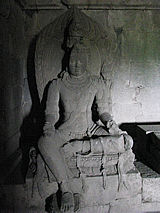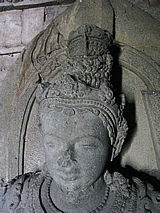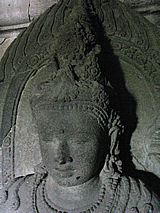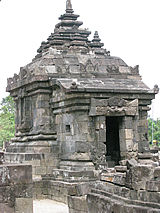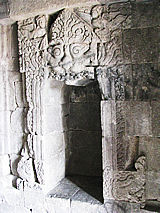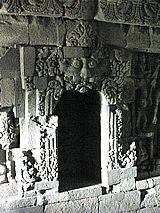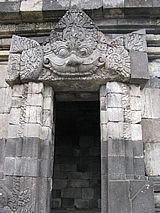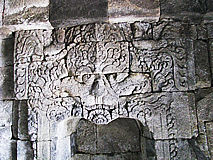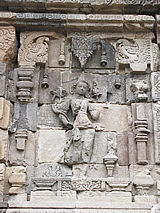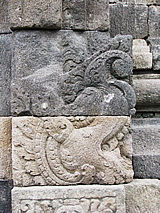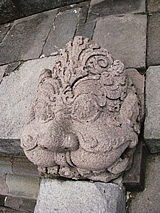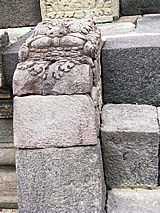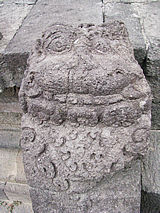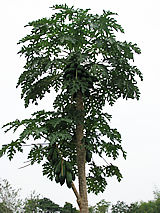Official website
of
HAN MARIE STIEKEMA
VIVA! JAVA
* Javanese mysticism
(Kebatinan) & Traditional Javanese religious tolerance: a model to the world?
*The Yogya Kraton Myth
*Taman Sari
*The Gunungan
*Tutup Ngisor
*What we can do for Java....
*Java: Land of Kala, its Candi's (Temples):
*Borobudur 1
*Borobudur 2
*Borobudur 3
*Borobudur 4
*Borobudur 5
*Borobudur 6
*Candi Mendut
*Candi Pawon
*Candi Ngawen
*Candi Sari
*Candi Kalasan
*Candi Sambisari
*Candi Prambanan
*Candi Lumbung
*Candi Bubrah
*Candi Sewu
*Candi Plaosan
*Candi Gebang
*Candi Ijo
*Candi Banyunibo
Candi Plaosan 2
A surprise right from the
start
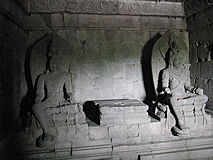 Bodhisattva's in Birth Chamber |
CANDI PLAOSAN |
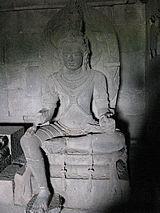 |
|
||
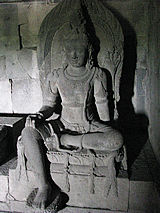 |
Because researchers mostly emphasize details the common denominators are lost in tsunamis of complexities. For instance, the simple fact, that every temple chamber is in fact a (re)birth chamber is often or altogether overlooked. Even where one has a good intuition - Mark Long called his book about Mendut "Womb of the Tathagatha" - no consequences are drawn from it. |
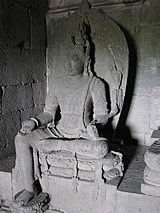 |
The "Young Boys" in their transformation process |
||
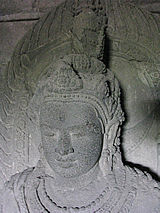 |
The chambers of the temple are situated in its deepest centre, dark and massive. Indeed, the comparison with a womb is striking. In Plaosan these chambers contain statues of Bodhisattva's. One may assume that nothing is accidental e.g. that everything has a meaning or purpose. That the women of Plaosan certainly aimed at emphasizing rebirth through the Cosmic Womb is very likely. The Bodhisattva's are about to become reborn. It isn't so important who they are - Manjusri, Maitreya and others - the emphasis lies on their being Sons of the Mother. The Mother stays, the Sons come and go. The ancient Javanese concept - aimed at by the women - the dynastic lineage through "death and rebirth" and that of Buddhism - spiritual transformation and renewal - complement each other here. Ultimately, everything has its roots in the archaic "Mother and Son/Lover" complex of the Near East (Sumeria), where the Sons are serving the Whole through ongoing "death and resurrection" |
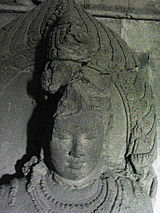 |
|
||
 |
There was a sense of great urgency. For Buddhism suffered rapid decline. The dynasty of the Sailendra's was on its return. It is the reason why especially the women "en masse" engaged themselves in saving the belief. They did it - how could it be otherwise - through emphasizing renewal through rebirth. The "world" needed new hopefuls. That's why Plaosan doesn't have, but IS a birth chamber. The entire temple was part of this effort. Striking detail. In one of the birth chambers - with the Bodhisattva's about to become reborn - an image of a mother with children (Hariti?) is decorating the wall. Clearly a fertility symbol. |
 Just a mother or the Goddess Hariti? |
Outside, the group of reborn Bodhisattvas....typically as a group instead of individuals |
||
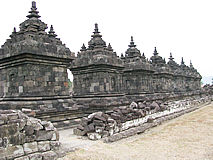 |
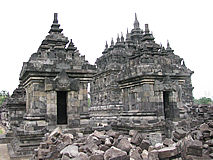 |
|
|
||
 |
THE UNIVERSAL KALA |
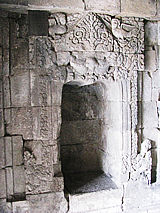 |
|
||
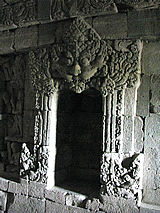 |
As promised here the display of the many Kala's at Plaosan. It is approximately half of all the Kala photo's I took. |
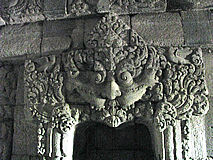 |
|
||
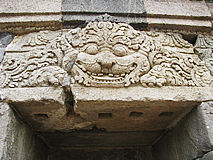 |
 |
|
|
||
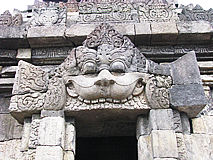 |
As explained in many other places, to me Kala is the Original Cosmic Mother, later (by Hinduism, Buddhism) turned into an (ugly) Demon/Guard. Many think She is the "God of Time". There is a logic in it, for the Mother is the "Cauldron of Death and Rebirth", thus "controlling time". The Kala Face expresses a perfect balance between the two. Her mouth is the devouring part, symbolizing destruction. However, the mouth has (mostly) no teeth expressing the fact, that destruction is a natural process. Many Kala's have an extended forehead in the shape of a Tree of Life, the Creation part of Cosmic Balance.* Her big eyes express Emptiness (beyond Emptiness) as Her "True Nature".... * The same symbolism one can find in the Gunungan, the national symbol of Java/Indonesia |
 |
|
||
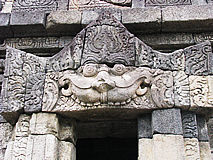 |
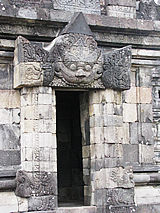 |
|
| "Javanese culture has strong feminine traits". Often one can hear this remark. However, this "vague" feeling is never worked out. Through my research, though, this claim for the first time has become substantiated. Its impact is far-reaching. Deep down the origins of Javanese culture may indeed have been based on a very present feminine impulse. |
|
|
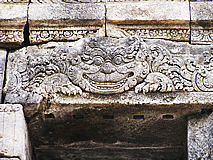 |
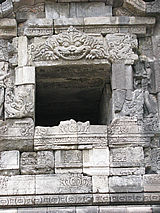 |
|
|
||
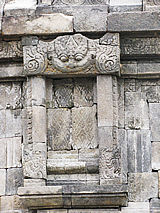 |
The Womb symbolism is almost inexhaustible at Plaosan (and many other Candi's). Next to what I already described above, the "Cauldron of Abundance" (in the West known as the Holy Grail!) can be added to it. It is a universal symbol and can be found everywhere, from Europe to China, from the Moslem cemetary of Istanbul to India and Indonesia. See below. |
 |
Kala with Cauldron |
||
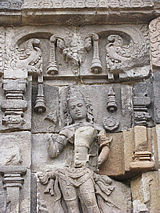 Bodhisattva with the Makara's above him |
The masculine principle at Plaosan is represented in various ways as well. After all, the whole effort of Plaosan is to give birth to new (male) avatars. Although the foundation is feminine, the projected hope for the future is embodied by males: the Sons of the Mother. Like it was in very ancient times. First to be mentioned are the various Bodhisattvas. Typically, the hope is not concentrated on one (like e.g. at Borobudur, where the emphasis lies on Maitreya as the next Buddha), but on many. According to the principle "One Mother and many Sons". Bodhisattva's are portrayed inside the chambers as well as outside on temple walls. The many "Heads in the Womb" (Plaosan part 1) prove the obsession with the rebirth of the male hopefuls. |
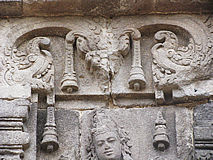 Ditto |
Ditto |
The second manifestation of the masculine one can find in the Kala-Makara's. Look at the Kala pictures above. Many have two "wings" with at the end a dragon-like open mouth. Often the mouth has a lion in it. These wings are the two Cosmic Forces "emanating" from Kala's Womb. One is Creation, the other Destruction. The Centre (Kala) is Emptiness (feminine), while the Forces are active (masculine). Sometimes the Makara's are portrayed as "independent" forces. Like the images shown here. | |
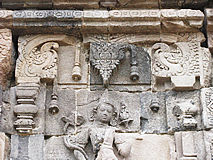 Ditto |
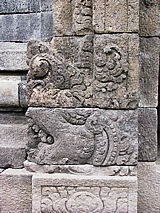 Often Makara's originate from a Kala on top of a door, while they themselves are at the bottom of the door post |
|
Ditto |
||
 Ditto |
The Makara (Dragon) Masks |
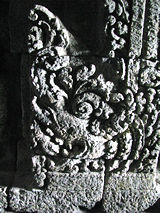 Ditto |
Green Lion |
||
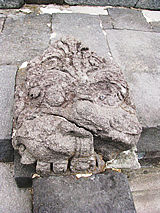 |
The last and most humble manifestation of the male principle are the lion/guards. They too, like Kala, originate from ancient (pre-Hindu and pre-Buddhist) times. In those times they were the Vegetation Gods of the Mother, going through their cyclic "death and resurrection". Through it people hoped to secure fertility and a good harvest. In later times these Gods were downgraded as guards. Exactly the same phenomenon one can observe in Europe! There the Gods became "Green Cats", "Green Lions" and eventually "Green Men". Many images of the "Lady and Her Beasts" remind us of the close relationship between the Mother and Her Son/Lovers. At Plaosan "Green Lions" abound. They are - like in Europe - portrayed with foliage around their faces. |
 |
|
||
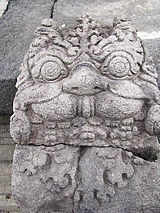 |
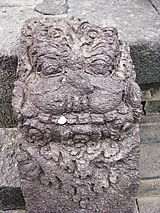 |
|
|
||
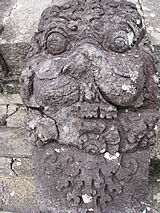 |
PS. Candi Sewu contains a lot of beautiful "Green Lions" |
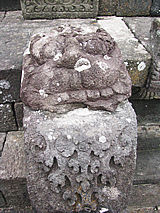 |
|
||
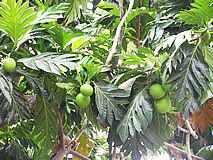 |
With gratefulness to the land of Java and its inhabitants |
Concluding, I am aware that my research is the first integrated approach to Javanese Candi's. It has the power of interconnectedness, depth and logic, based on comparative observation against the background of Javanese (pre-patriarchal) origins. If I am right these results will cause a "landslide"; if I am wrong - which I always include as a possibility - then the research was one of my most beautiful dreams. I dedicate my work to the Javanese people in general and to those Kebatinan groups who search for their true origin in particular. May the latter decide in some future, what their final truth is.... |
Prambanan-4
1997-2011
© Copyright Han Marie Stiekema. All rights reserved.
Everyone may use this website as a source of inspiration. However, since it
is freely given, no-one can claim, copy or derive any text, rights,
position or status from this website.
Last revising: 07/22/12
